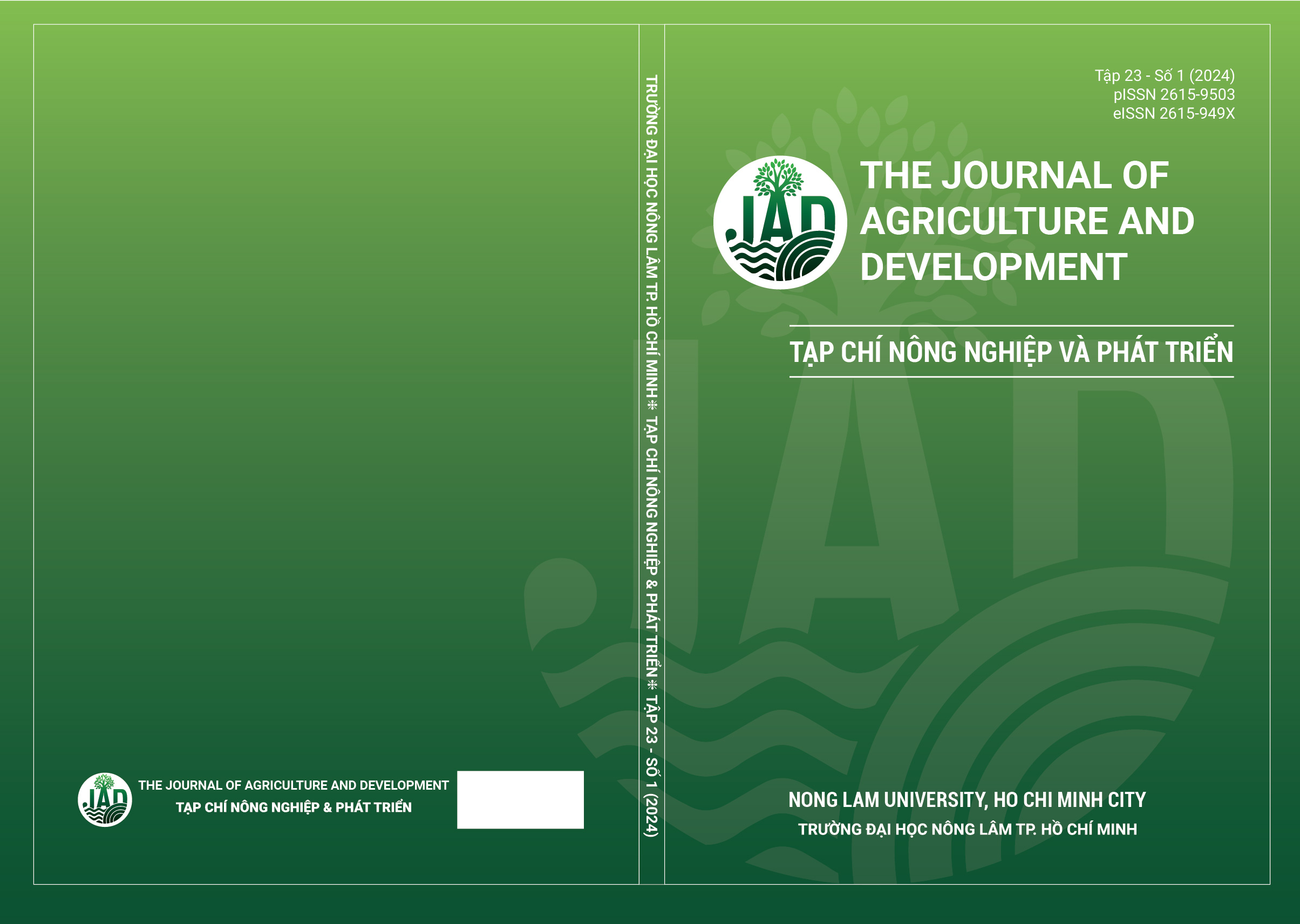The leaf litter consumption and occurrence of sesarmid crab Parasesarma plicatum (Latreille, 1803) on habitats in Can Gio mangrove forest
Main Article Content
Abstract
The experiment was conducted from September to December, 2022 to identify the consumption of Parasesarma plicatum (Latreille, 1803) on different Rhizophora apiculata leaf litter conditions (senescent: yellowish in color, decomposition: red brown and black brown color) in a 72-h experiment with 2 crab sizes. The experiment was designed with 6 treatments and 5 replicates. Each treatment used 5 crabs which were provided with 1 type of leaves as their food. The treatments included T1: 5 bigger size crab + yellowish leaf, T2: 5 bigger size crab + reddish brown leaf, T3: 5 bigger size crab + black brown leaf, T4: 5 small crabs + yellowish leaf, T5: 5 small crabs + reddish brown leaf, and T6: 5 small crabs + black brown leaf. The results showed that the consumption of black brown leaf litter of the bigger size crab was the highest in weight and significantly different from all other treatments. It also showed that Parasesarma plicatum did not like to eat yellowish leaf litter in all treatments. In addition, there was not a statistically significant difference in leaf litter consumption among smaller crab groups. The research on the occurrence of sesarmid crabs in Can Gio mangrove forest identified two suitable habitats for sesarmid crabs according to tidal elevation, mangrove type and environmental factors. The main factors affecting the occurrence of sesarmid crabs in the habitats were the coverage of shading trees and the mangrove type (Rhizophora apiculata, Ceriops decandra, Avicennia officinalis, Avicennia marina and Lumnitzera racemosa). Thus, Parasesarma plicatum could play an important role in the detrital food web in Can Gio mangrove forest.
Article Details
References
Chandra, P. S. K., & Keith, A. M. (2008). Feeding selectivity of sesarmid crabs from northern Australian mangrove forests (research report). Curtin University of Technology, Western Australia, Australia.
Dai, A. Y., & Yang, S. L. (1991). Crabs of the China sea. New York, USA: Springer-Verlag.
FAO (Food and Agriculture Organization of the United Nations). (2007). The world’s mangroves 1980-2005. Rome, Italy: FAO.
Kochey, K. J. (2013). Determination of thermal tolerance, density and distribution of the mangrove crabs, perisesarma guttatum (sesarmidae) and uca urvillei (ocypodidae) at gazi-bay, Kenya (Unpublished master’s thesis). Kenyatta University, Nairobi, Kenya.
Phan, H. N., Tran, B. V., Vien, N. N., Hoang, S. T., Vu, T. T., Le, T. T., Nguyen, T. H., Mai, T. S., & Le, T. X. (1999). Vietnam’s mangrove forests. Ha Noi, Vietnam: Agricultural Publishing House.
Ravichandran, S., Fredrick, W. S., Khan, S. A., & Balasubramanian, T. (2011). Diversity of mangrove crabs in South and South East Asia. Journal of Oceanography and Marine Environmental System 1(1), 1-7.
Robertson, A. I. (1986). Leaf-burying crabs: their influence on energy flow and export from a mangrove forest (Rhizophora spp.) in northeastern Australia. Journal of Experimental Marine Biology and Ecology 102(2-3), 237-248. https://doi.org/10.1016/0022-0981(86)90179-6.
Sandilyan, S., & Kathiresan, K. (2012). Mangrove conservation: a global perspective. Biodiversity and Conservation 21, 3523-3542. https://doi.org/10.1007/s10531-012-0388-x.
Thongtham, N., & Kristensen, E. (2005). Carbon and nitrogen balance of leaf-eating sesarmid crabs (Neoepisesarma versicolor) offered different food sources. Estuarine, Coastal and Shelf Science 65(1-2), 213-222. https://doi.org/10.1016/j.ecss.2005.05.014.
Tran, M. N. D., Karen Diele, & Triet Tran. (2011a). Biodiversity and role of Brachyuran crabs in leaf litter decomposition on typhoon destroyed areas at Can Gio mangrove, Ho Chi Minh City. Science and Technology Development Journal 14(3), 146-153.
Tran, M. N. D., Nguyen, H. D., & Do, H. T. T. (2011b). Comparison of Perisesarma Eumolpe’s food composition and food rate between undamaged and damaged areas at Can Gio mangrove, Ho Chi Minh City. Science and Technology Development Journal 9(5), 780-786.








